AMD’s Radeon HD 6870 & 6850: Renewing Competition in the Mid-Range Market
by Ryan Smith on October 21, 2010 10:08 PM ESTLast but not least in our look at AMD’s new Radeon 6800 series is our look at power consumption, GPU temperatures, and the amount of noise generated. With efficiency being one of the major design goals for Barts, AMD stands to gain a lot of ground here compared to the 5800 series for only a minor drop in performance.
Looking quickly at the voltages of the 6800 series, we have 4 samples – 2 each of the 6870, and 2 each of the 6850. Both of our 6870 cards have an idle voltage of 0.945v and a load voltage of 1.172v, and seeing as how they’re both based on AMD’s reference design this is what we would expect for a design that is based around a single VID.
However our 6850 results, which include a non-reference card in the form of XFX’s customized 6850, are much more interesting. While our reference 6850 has a load voltage of 1.094v, our XFX card reports a load voltage of 1.148v. We’ll be taking a look at the XFX 6850 in-depth next week in our 6850 roundup, but for now this leaves us with the question of whether AMD is using variable VIDs, or if XFX is purposely setting theirs higher for overclocking purposes.
| Radeon HD 6800 Series Load Voltage | |||||
| Ref 6870 | XFX 6870 | Ref 6850 | XFX 6850 | ||
| 1.172v | 1.172v | 1.094v | 1.148v | ||
Finally our EVGA GTX 460 1GB FTW card has a VID of 0.975v, which compared to all the other GTX 460 cards we’ve tested thus far makes it quite notable. This is lower than any of those other cards by 0.012v, a property we believe is necessary to sell such a heavily overclocked card without causing a similarly large rise in power/heat/noise. It’s also for this reason that we question whether NVIDIA could actually supply suitable GF104 GPUs in high volumes, as GPUs capable of running at this voltage are likely coming from the cream of the crop for NVIDIA.
For our tests, please note that we do not have a pair of reference 6850s. For our second 6850 we are using XFX’s customized 6850 card, which means our results will undoubtedly differ from what a pair of true reference cards would do. However as the 6850 reference design will not be widely available this is less important than it sounds.
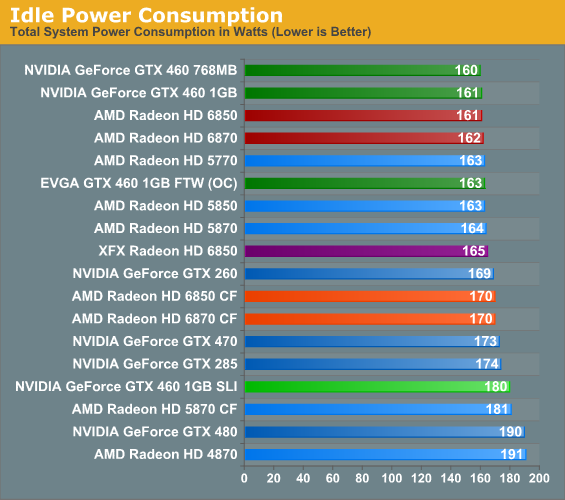
As always we start our look at power/temp/noise with our look at idle power. Because we use a 1200W PSU in our GPU test rig our PSU efficiency at idle is quite low, leading to the suppression of the actual difference between cards. But even with this kind of suppression it’s still possible to pick out what cards have a lower idle power draw, as the best cards will still result in a total system power draw that’s at least a couple of watts lower.
AMD’s official specs call for the 6800 series to have a lower idle power draw than the 5800 series, and while we can’t account for all 8 watts we do manage to shave a couple of watts off compared to our 5800 series cards. The Crossfire results are even more impressive, with the 6870CF drawing 11W less than the 5870CF.
Compared to the 6800 series the GeForce GTX 460 768MB does manage to hang on to top honor here for a single card by a watt, however in SLI our 1GB cards do worse than our 6800 series cards by 10W.
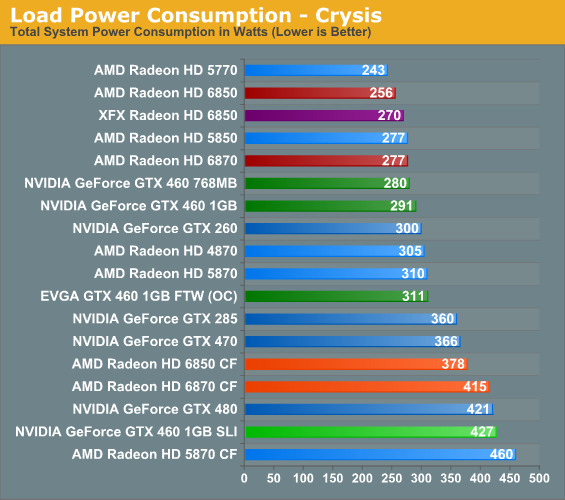
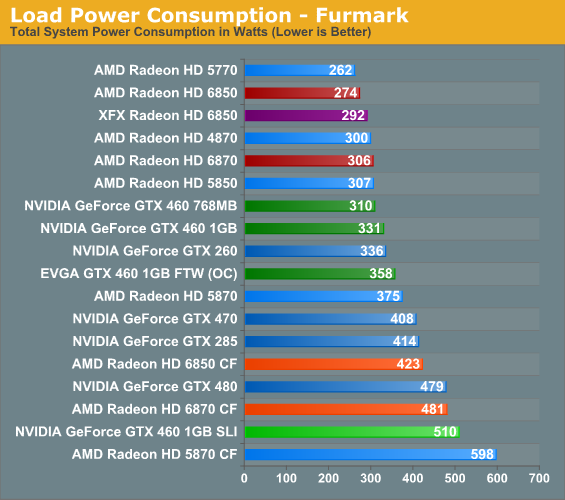
Looking at load power consumption it’s clear from the start that AMD’s efficiency gains are going to pay off here. On the latest iteration of our power consumption chart the 6850 underconsumes even the already conservative 5850 by 20W under Crysis and 25W under FurMark, showcasing how AMD was able to reduce their power consumption by a significant amount while giving up much less in the way of performance.
Compared to the 6800 series NVIDIA does notably worse here, with all of the GTX 460 cards pulling down more power than the 6870 and the GTX 470 being in a league of its own. While NVIDIA was competitive with Cypress on power, they’re not in a position to match Barts. They can deliver Barts-like performance (and then some), but they have to consume more power to do it.
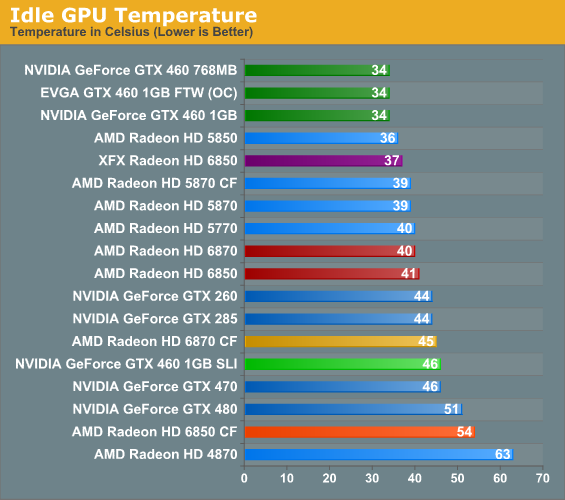
Up next is our look at GPU temperatures, starting with idle temps. As we mentioned in our GTX 460 review, NVIDIA ended up producing a very effective reference cooler for the GTX 460, utilizing an open-air design that by dissipating air inside and outside of the case is capable of reaching temperatures fully exhausting coolers can’t match. As a result all of the GTX 460 cards top our charts here.
Prior to the GTX 460 series this is a metric the 5850 always did well in, so we had expected a similar performance from the 6850, only to leave disappointed. What we’re ultimately looking at is a matter of the quality of the cooler: the 6850 may consume less power than the 5850 at idle, but it packs a weaker cooler overall, allowing it to approach these temperatures. For a gaming card such as the 6800 series idle temperatures are almost entirely superficial once we get below 50C, but even so this tells us something about the 6850 reference cooler.
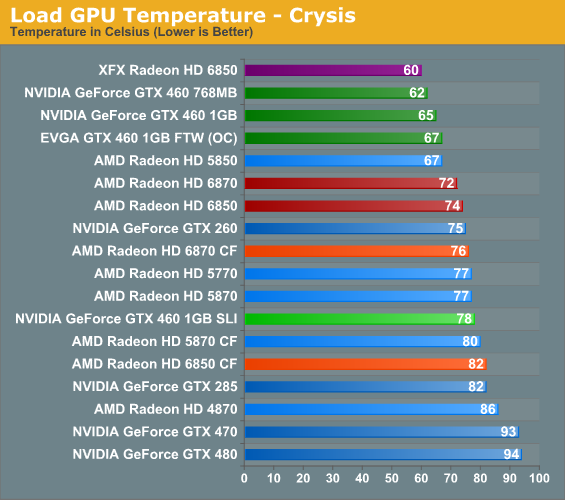
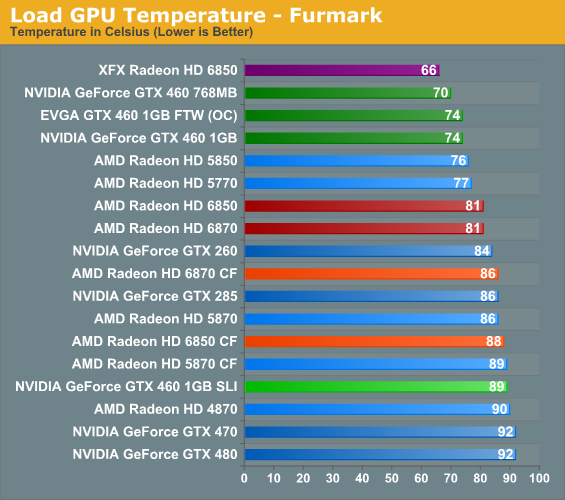
Thanks to the GTX 460’s open-air cooler, all of our GTX 460 cards top our temperature chart even with their higher power consumption. The trade-off is that all of these cards require a well-ventilated case, while the Radeon 5800 and 6800 series will tolerate much poorer cases so long as there’s enough ventilation for the card to pull in air in the first place.
As was the case with idle temperatures, the reference 6850 ends up doing worse than the 5850 here thanks to its less effective cooler; however the 6870 ends up doing better than both the 6850 and 5870 due to its more effective cooler and its lower power consumption compared to the 5870. While these cards can’t quite touch the GTX 460 series, we’re still looking at some of the coolest cards among our current benchmark suite.
Meanwhile our XFX 6850 ends up doing the best out of all of our cards here, however this will come at a cost of more noise. We'll touch on this more next week in our 6850 roundup.
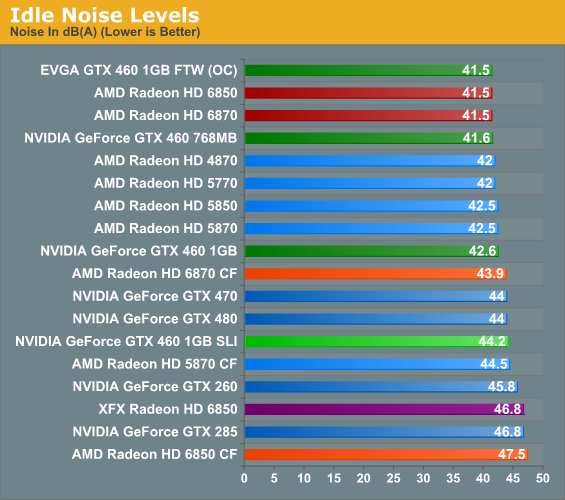
Last but not least is idle noise, which isn’t much of a story with modern cards. With the exception of the GTX 470/480, the latest GeForce and Radeon cards are both capable of running up against the noise floor of our testing environment.
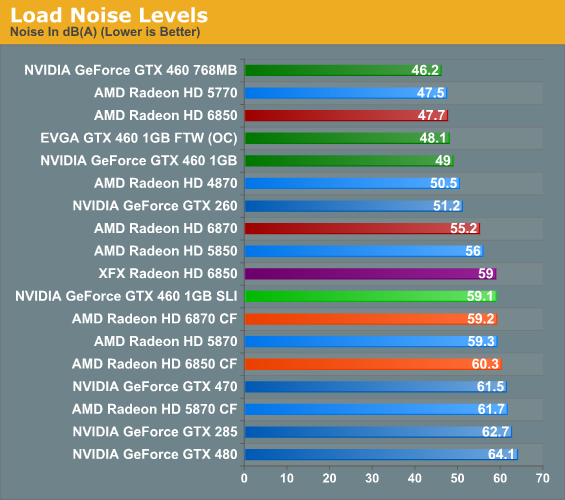
Under load we once again see an NVIDIA GTX 460 card top the chart thanks to its open-air design. This is followed very closely however by the Radeon 6850, which at 47.7dB is our third-quietest card and finally showing off the advantages of the tradeoffs AMD made with the reference cooler. The 6850 may not be as cool as the 5850, but it’s quite a bit quieter. As for the XFX card, this is where XFX has to pay the piper, as their 6850 card ends up being as loud as a 5870 in exchange for their lower temperatures.
Meanwhile the 6870 ends up being quite a bit louder than both the GTX 460 series and the 6850, coming in at 55.2dB. This is a definite leg-up compared to the 5870 and nicely cements the fact that the 6870 is intended to be the 5850’s replacement, but it means the GTX 460 series spoils the results here. Once custom-design vendor cards come out for the 6870, I suspect we’re going to see someone quickly sell a 6870 with a less aggressive cooler, which for the costs of higher temperatures would afford less noise.










197 Comments
View All Comments
Quidam67 - Friday, October 29, 2010 - link
Well that's odd.After reading about the EVGA FTW, and its mind-boggling factory overclock, I went looking to see if I could pick one of these up in New Zealand.
Seems you can, or maybe not. As per this example http://www.trademe.co.nz/Browse/Listing.aspx?id=32... the clocks are 763Mhz and 3.8 on the memory?!?
What gives, how can EVGA give the same name to a card and then have different specifications on it? So good thing I checked the fine-print or else I would have been bumbed out if I'd bought it and then realised it wasn't clocked like I thought it would be..
Murolith - Friday, October 29, 2010 - link
So..how about that update in the review checking out the quality/speed of MLAA?CptChris - Sunday, October 31, 2010 - link
As the cards were compared to the OC nVidia card I would be interested in seeing how the 6800 series also compares to a card like the Sapphire HD5850 2GB Toxic Edition. I know it is literally twice the price as the HD6850 but would it be enough of a performance margin to be worth the price difference?gochichi - Thursday, November 4, 2010 - link
You know, maybe I hang in the wrong circles but I by far keep up to date on GPUs more than anyone I know. Not only that, but I am eager to update my stuff if it's reasonable. I want it to be reasonable so badly because I simply love computer hardware (more than games per say, or as much as the games... it's about hardware for me in and of itself).Not getting to my point fast enough. I purchased a Radeon 3870 at Best Buy (Best Buy had an oddly good deal on these at the time, Best Buy doesn't tend to keep competitive prices on video cards at all for some reason). 10 days later (so I returned my 3870 at the store) I purchased a 4850, and wow, what a difference it made. The thing of it is, the 3870 played COD 4 like a champ, the 4850 was ridiculously better but I was already satisfied.
In any case, the naming... the 3870 was no more than $200.00 I think it was $150.00. And it played COD4 on 24" 1900x1200 monitor with a few settings not maxed out, and played it so well. The 4850 allowed me to max out my settings. Crysis sucked, crysis still sucks and crysis is still a playable benchmark. Not to say I don't look at it as a benchmark. The 4850 on the week of its release was $199.99 at Best Buy.
Then gosh oh golly there was the 4870 and the 4890, which simply took up too much power... I am simply unwilling to buy a card that uses more than one extra 6-pin connector just so I can go out of my way to find something that runs better. So far, my 4850 has left me wanting more in GTA IV, (notice again how it comes down to hardware having to overcome bad programming, the 4850 is fast enough for 1080p but it's not a very well ported game so I have to defer to better hardware). You can stop counting the ways my 4850 has left me wanting more at 1900 x 1200. I suppose maxing out Starcraft II would be nice also.
Well, then came out the 5850, finally a card that would eclipse my 4850... but oh wait, though the moniker was the same (3850 = so awesome, so affordable, the 4850 = so awesome, so affordable, the 5850 = two 6-pin connectors, so expensive, so high end) it was completely out of line with what I had come to expect. The 4850 stood without a successor. Remember here that I was going from 3870 to 4850, same price range, way better performance. Then came the 5770, and it was marginally faster but just not enough change to merit a frivolous upgrade.
Now, my "need" to upgrade is as frivolous as ever, but finally, a return to sanity with the *850 moniker standing for fast, and midrange. I am a *850 kind of guy through and through, I don't want crazy power consumption, I don't want to be able to buy a whole, really good computer for the price of just a video card.
So, anyhow, that's my long story basically... that the strange and utterly upsetting name was the 5850, the 6850 is actually right in line with what the naming should have always staid as. I wouldn't know why the heck AMD tossed a curve ball for me via the 5850, but I will tell you that it's been a really long time coming to get a true successor in the $200 and under range.
You know, around the time of the 9800GT and the 4850, you actually heard people talk about buying video cards while out with friends. The games don't demand much more than that... so $500 cards that double their performance is just silly silly stuff and people would rather buy an awesome phone, an iPad, etc. etc. etc.
So anyhow, enough of my rambling, I reckon I'll be silly and get the true successor to my 4850... though I am assured that my Q6600 isn't up to par for Starcraft II... oh well.
rag2214 - Sunday, November 7, 2010 - link
The 6800 series my not beat the 5870 yet but it is the start of the HDMI 1.4 for 3dHD not available in any other ATI graphics cards.Philip46 - Monday, November 15, 2010 - link
The review stated why was there a reson to buy a 460(not OC'ed).How about benchmarks of games using Physx?
For instance Mafia 2 hits 32fps @ 1080p(I7-930 cpu) when using Physx on high, while the 5870 manages only 16.5fps, while i tested both cards.
How about a GTA:IV benchmark?, because the Zotac 2GB GTX 460, runs the game more smoothly(the same avg fps, except the min fps on the 5850 are lower in the daytime) then the 5850 (2GB).
How about even a Far Cry 2 benchmark?
Co'me on anandtech!, lets get some real benchmarks that cover all aspects of gaming features.
How about adding in driver stability? Ect..
And before anyone calls me biased, i had both the Zotac GTX 460 and Saffire 5850 2GB a couple weeks back, and overall i went with the Zotac 460, and i play Crysis/Stalker/GTA IV/Mafia 2/Far Cry 2..ect @ 1080p, and the 460 just played them all more stable..even if Crysis/Stalker were some 10% faster on the 5850.
BTW: Bad move by anandtech to include the 460 FTC !
animekenji - Saturday, December 25, 2010 - link
Barts is the replacement for Juniper, NOT Cypress. Cayman is the replacement for Cypress. If you're going to do a comparison to the previous generation, then at least compare it to the right card. HD6850 replaces HD5750. HD6870 replaces HD5770. HD6970 replaces HD5870. You're giving people the false impression that AMD knocked performance down with the new cards instead of up when HD6800 vastly outperforms HD5700 and HD6900 vastly outperforms HD5800. Stop drinking the green kool-aid, Anandtech.